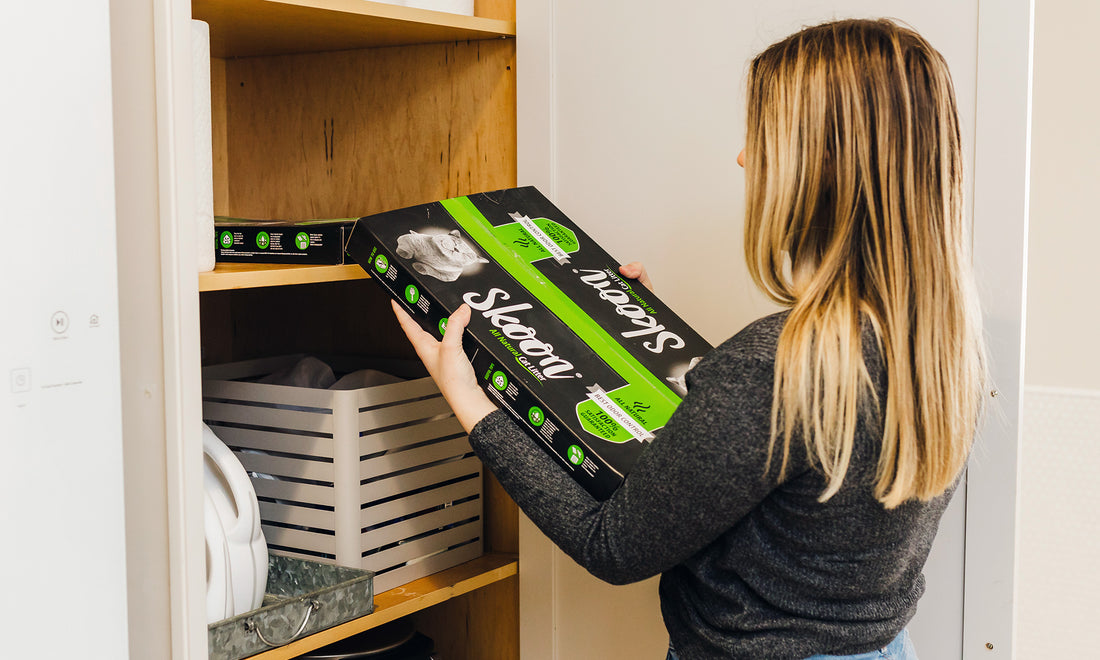
Cat Owners Who Love Non-Clumping Cat Litter
Why Cat Owners Love Non-clumping Cat Litter
You have to make so many tough decisions as a cat owner, from the type of food they eat (wet, dry or a healthy mix of the two) to the kind of cat litter you use to fill their litter box. While it may not be nearly as exciting as cat trees and toys, finding the right cat litter for your furry friend should always be the first priority (along with food, of course). This leads us to one of the most important questions: Clumping or non-clumping cat litter? You may think that the difference is obvious (well, it kind of is), but these two types of kitty litter cater to your cat’s health along with their personal preferences. In most cases, you can use either type of cat litter — whatever your cat likes best. Kittens, however, should start with non-clumping cat litter since it’s lighter in weight, softer on their little paws and is less of an eating or choking hazard. After a few months, it’s safe to move forward with clumping litter, but if you use the right one in the first place (ahem, Skoon), you may just want to stick with what works. But before we let some actual cat owners tell you what’s what, learn more about the benefits of using non-clumping cat litter, as well as how to pick the right variety for your feline.
This leads us to one of the most important questions: Clumping or non-clumping cat litter? You may think that the difference is obvious (well, it kind of is), but these two types of kitty litter cater to your cat’s health along with their personal preferences. In most cases, you can use either type of cat litter — whatever your cat likes best. Kittens, however, should start with non-clumping cat litter since it’s lighter in weight, softer on their little paws and is less of an eating or choking hazard. After a few months, it’s safe to move forward with clumping litter, but if you use the right one in the first place (ahem, Skoon), you may just want to stick with what works. But before we let some actual cat owners tell you what’s what, learn more about the benefits of using non-clumping cat litter, as well as how to pick the right variety for your feline.
The Benefits of Using Non-Clumping Cat Litter
Clumping cat litter exists purely for the cat owner. The litter contains ‘bentonite,’ which causes urine to solidify into a mass as it absorbs the liquid. It’s simple: When the clumps form, they are easier to spot, so cat owners know exactly what needs to be removed. But still, non-clumping cat litter is better at absorbing large volumes of cat urine, masking odor for a more extended period. You’ll even find some cat litters are made with baking soda or charcoal, which are specifically designed to get rid of inevitable odors. Just an FYI: Even if the cat litter can absorb more cat pee, it doesn’t mean you can get away with cleaning the litter box less often.
The Different Types of Non-Clumping Cat Litter to Try
 Even though most non-clumping kitty litters boast tons of benefits, some materials work better than others. Here, you’ll find a range of non-clumping cat litter varieties to choose from— some are best at handling smelly odors, others are more environmentally friendly.
Even though most non-clumping kitty litters boast tons of benefits, some materials work better than others. Here, you’ll find a range of non-clumping cat litter varieties to choose from— some are best at handling smelly odors, others are more environmentally friendly.
- Diatomite cat litter, like Skoon, has a sponge-like structure that traps odor-causing particles, decreases moisture concentration and maximizes absorption.
- Clay cat litter absorbs the odor of whatever your cat leaves behind, but it can also be used to deodorize other parts of your house or garden.
- Crystal cat litter is a non-clumping option made out of silica crystals. It lasts longer than other options and is super light, making your weekly cleanup even easier.
- Pine cat litter is a more natural way to absorb cat odors. The non-clumping variety is lightweight and dust-free, two musts for any cat owner.
- Paper pellet cat litter is made out of recycled paper material, often newspaper. It’s softer than the other varieties on this list, making it ideal for older cats or those with injured paws. One minor detail: It doesn’t control odor very well, so it should only be used short-term.
Why Cat Owners Made the Switch to Non-Clumping Cat Litter
Some cat owners will introduce their kittens to non-clumping cat litter and never try anything else. Others will switch to a clumping variety when their cat reaches a certain age … and then question if they made the right choice. As a reminder, the best cat litter you can use is the one that your cat likes the best. But if it was up to us, we’d obviously put Skoon at the top of the list. Don’t just take it from us, though: Read why three actual cat owners swear by Skoon.
“It helped my cat’s asthma.”
 Boone has asthma, which means his owner Jenna Barinas from Pittsburgh, PA, is always on the hunt for dust-free cat litter. A lot of the litters labeled as “no dust” actually have some kind of dust — something only cat owners with asthmatic cats would notice. When Jenna switched Boone over to Skoon, she noticed that his breathing quickly improved. Plus, it gave her peace of mind since she knew that the pebbles absorbed the liquid, so she didn’t have to compromise her cat’s health while keeping odors at bay. “Not to mention he’s a long-haired cat, so litter (and just about anything else) gets caught in his hair. With Skoon, that’s not a problem,” she tells us.
Boone has asthma, which means his owner Jenna Barinas from Pittsburgh, PA, is always on the hunt for dust-free cat litter. A lot of the litters labeled as “no dust” actually have some kind of dust — something only cat owners with asthmatic cats would notice. When Jenna switched Boone over to Skoon, she noticed that his breathing quickly improved. Plus, it gave her peace of mind since she knew that the pebbles absorbed the liquid, so she didn’t have to compromise her cat’s health while keeping odors at bay. “Not to mention he’s a long-haired cat, so litter (and just about anything else) gets caught in his hair. With Skoon, that’s not a problem,” she tells us.
“It comforts my cat’s sensitive skin.”
 Tom was struggling to find a non-clumping cat litter that didn’t irritate his cat’s (Meera and Sweetpea) sensitive skin. Although there was a short adjustment period when he initially made the switch, he was delighted to find that Skoon didn’t bother their skin. Because it’s non-toxic, low dust and hypoallergenic, Skoon is also a good choice for everyone in your home, especially if they suffer from allergies or asthma, just like Meera and Sweetpea. Even better: “The added bonus of delivery, as well as the minimal maintenance, made Skoon a great choice for our family,” he continues.
Tom was struggling to find a non-clumping cat litter that didn’t irritate his cat’s (Meera and Sweetpea) sensitive skin. Although there was a short adjustment period when he initially made the switch, he was delighted to find that Skoon didn’t bother their skin. Because it’s non-toxic, low dust and hypoallergenic, Skoon is also a good choice for everyone in your home, especially if they suffer from allergies or asthma, just like Meera and Sweetpea. Even better: “The added bonus of delivery, as well as the minimal maintenance, made Skoon a great choice for our family,” he continues.
“It’s easier to clean if you have lots of cats.”
 The more cats you have, the more litter boxes you need. With Skoon, multiple cats can share a litter box (if they’re willing) since it’s easier for the owners to clean and manage odors. Bob, Gandolf and Merlin all share the same litter box (FYI: Typically, it’s best to have one litter box per cat.), and it’s made possible by Skoon: “All I need to do is scoop the poop and deal with the urine only every four days when I change the entire box. While there is still tracking, it’s much less than regular litter, and it’s fantastic on odor control,” their owner tells us. Every few days, scoop out the solids and stir around the litter pebbles to make sure everything absorbs appropriately. Then just keep an eye out for the litter to turn an off-white color, a sign that it’s time to replace the litter completely. Ready to make the switch? Here’s the best way to introduce your cat to a new cat litter:
The more cats you have, the more litter boxes you need. With Skoon, multiple cats can share a litter box (if they’re willing) since it’s easier for the owners to clean and manage odors. Bob, Gandolf and Merlin all share the same litter box (FYI: Typically, it’s best to have one litter box per cat.), and it’s made possible by Skoon: “All I need to do is scoop the poop and deal with the urine only every four days when I change the entire box. While there is still tracking, it’s much less than regular litter, and it’s fantastic on odor control,” their owner tells us. Every few days, scoop out the solids and stir around the litter pebbles to make sure everything absorbs appropriately. Then just keep an eye out for the litter to turn an off-white color, a sign that it’s time to replace the litter completely. Ready to make the switch? Here’s the best way to introduce your cat to a new cat litter:
- Slowly add small amounts of the new kitty litter to the box of old litter over a seven to 10-day period (or until your cat seems to be comfortable enough to go to the bathroom).
- Watch your cat’s bathroom behavior throughout the next few weeks to see if there are any changes. If your cat completely avoids the litter box, place a few litter boxes with different kinds of litter throughout your house to put the power in their paws.
- If at any point you notice that they are going to the bathroom outside of its litter box, check in with your vet since it may be a sign of a bigger cat health issue.
If you want to give your kitty a cleaner, better cat litter option, get started with Skoon. We offer a variety of non-clumping scents, ideal for kittens and multi-cat households.


